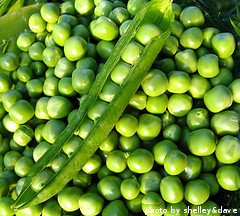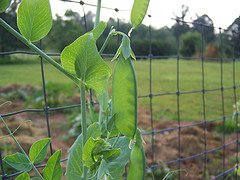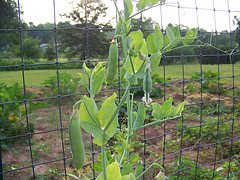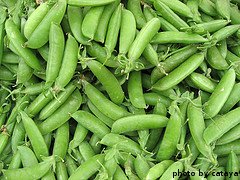Harvesting Peas - A How-To Guide
When harvesting peas, check the appearance of the pods to determine if they are ready to be picked. Peas have the best, sweetest flavor if they are picked at just the right time. Harvest too early and the pods will be small with only a few peas inside. Wait too late and the pods become fibrous and the peas inside lose much of their sweetness. Here are some tips for determining if your peas are ready to be picked.

Garden Peas
When harvesting peas that will need to be shelled, check to see that the pod is round and bright green. It should also be somewhat shiny. There should be no visible bumps. These are indications that your peas have reached their peak and are ready to be harvested. If you wait too long, the pods will have bumps from the peas inside getting too large. The pods will also be dull green with no sheen. At this stage, your peas are over- ripe. You can still pick them and eat them, they just won't taste as good and may have a tough texture.
Snap Peas
When harvesting peas that have a round, edible pod, you also have a larger window of time to still get great flavor and texture. You can harvest them as early as you want to. You can also wait until the pods are large and rounded. As long as the pod appears to be shiny and not bulging, it will still taste sweet and have a good level of crispness. Once the peas begin to dull and get bulges, they are past their prime. You can still pick them and shell the peas to eat, but the pods will be fibrous and not taste as good. As with snow peas, it's better to pick snap peas too early rather than too late.
Snow Peas

When harvesting peas that have a flat, edible pod, you have a bigger window of time to still get great flavor. These peas can be picked as soon as they are big enough for your liking. As long as the peas inside the pod have not enlarged, you're in good shape. You can also gently squeeze the pods to see if there's a little movement around the peas inside. Once the peas inside become larger, the pod will be tighter, rounder and have a more fibrous texture. At this stage, the pods and peas will also lose much of their sweetness. When in doubt, it's better to pick snow peas too early rather than too late.
When harvesting peas of any variety, take great care when picking the pods from the vine. Pea plants have shallow root systems. If you aren't careful, you may pull the whole plant out of the ground when trying to pick a pea pod. The stems are also delicate and can break off easily. It's best to use 2 hands to pick peas. Use one of your hands to hold the vine and the other hand to gently pinch the pod off the plant.
Pea plants, like peppers, green beans and lots of other plants, will produce more if you keep picking the peas on a regular basis. Once the plants begin producing pods, you should be harvesting peas every 2-3 days to force the plants to produce more pods.

If it was up to them and weather conditions were ideal, pea plants would continuously produce pods throughout the year, as long as you kept picking them. However, pod production and quality begins to suffer greatly when hot weather appears. If you are growing a fall pea crop, harvest as many peas as you can before the first hard freeze, which will also shut down production. Once production stops, you can pull the plants up by the roots and add
them to your compost pile.
After harvesting garden peas, you'll need to remove the peas from the inedible pods. Use your fingernail or a small sharp knife to cut a slit down the length of the pod. Open the pod and empty out the peas. The pods can be added to your compost pile.
Since the pods of snow peas and snap peas are edible, they don't need to be shelled. Just trim off any remaining stems and eat them whole, pod and all.
Garden peas, snow peas and snap peas are best eaten as soon as possible after picking them. They will keep in the refrigerator for up to 7 days. Wash them off and store in an airtight container in the refrigerator. If you want to store peas for longer, you can freeze them. Just blanch them in boiling water for 2 minutes and them plunge them into ice-water to stop the cooking process. Once cool, you can pack the peas in airtight bags or containers and place them in the freezer. They will last for up to 9 months. You can use this method to freeze garden peas, snow peas and snap peas.
You can also use a dehydrator to dry shelled garden peas. Once dried out, they can be stored in airtight bags or containers and used later in stew or soup. This process doesn't work well for snap peas or snow peas. You can also leave the peas on the vine until the pods turn brown and brittle. The peas inside will dry out and can be shelled directly into airtight bags or jars.
Now that you know all about harvesting peas, it's time for a few of our favorite recipes that feature peas.

Click here for some of our favorite pea recipes
Click here to move from our Harvesting Peas page to our Growing Peas main page
Click here to go to our Home page